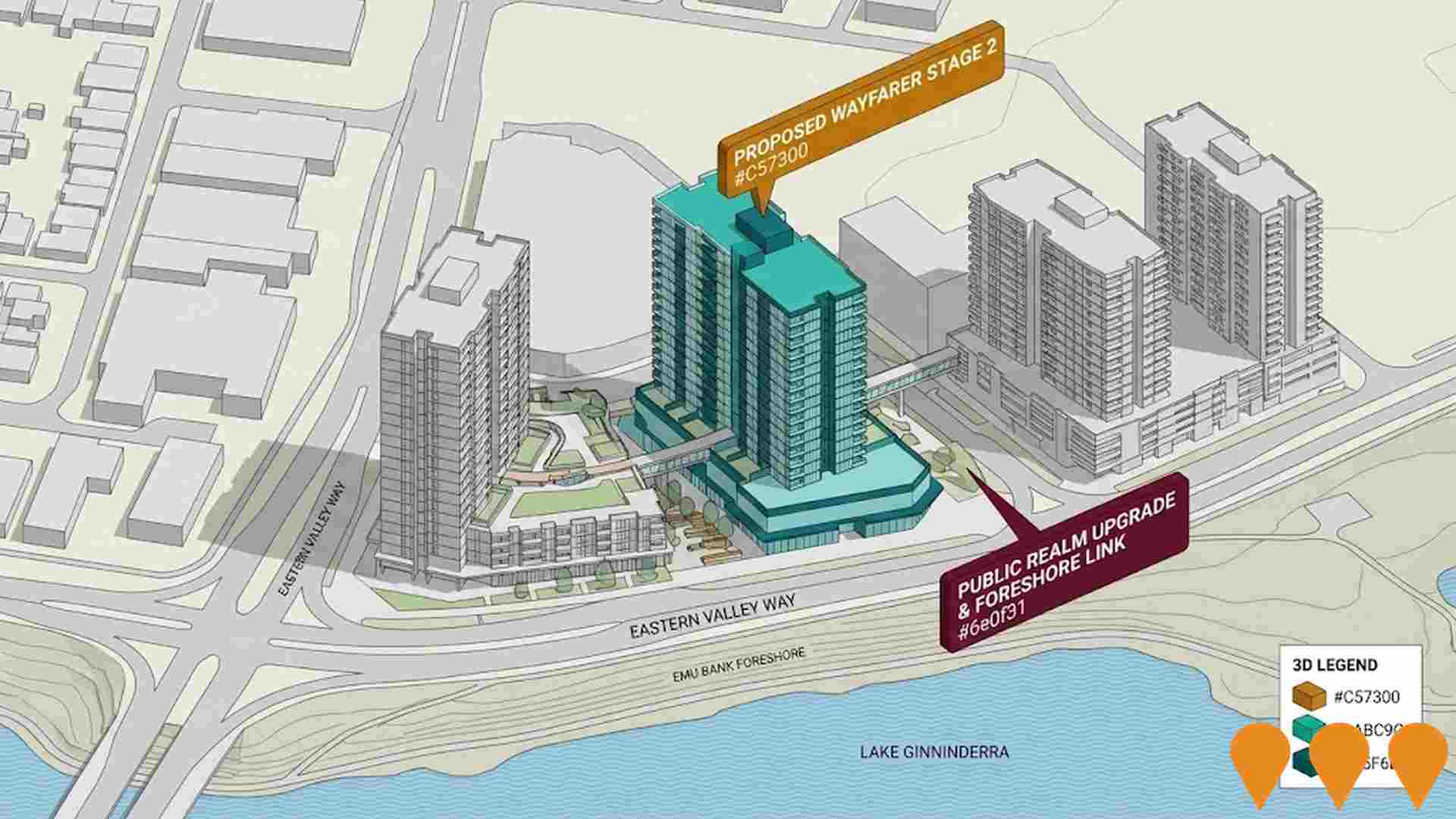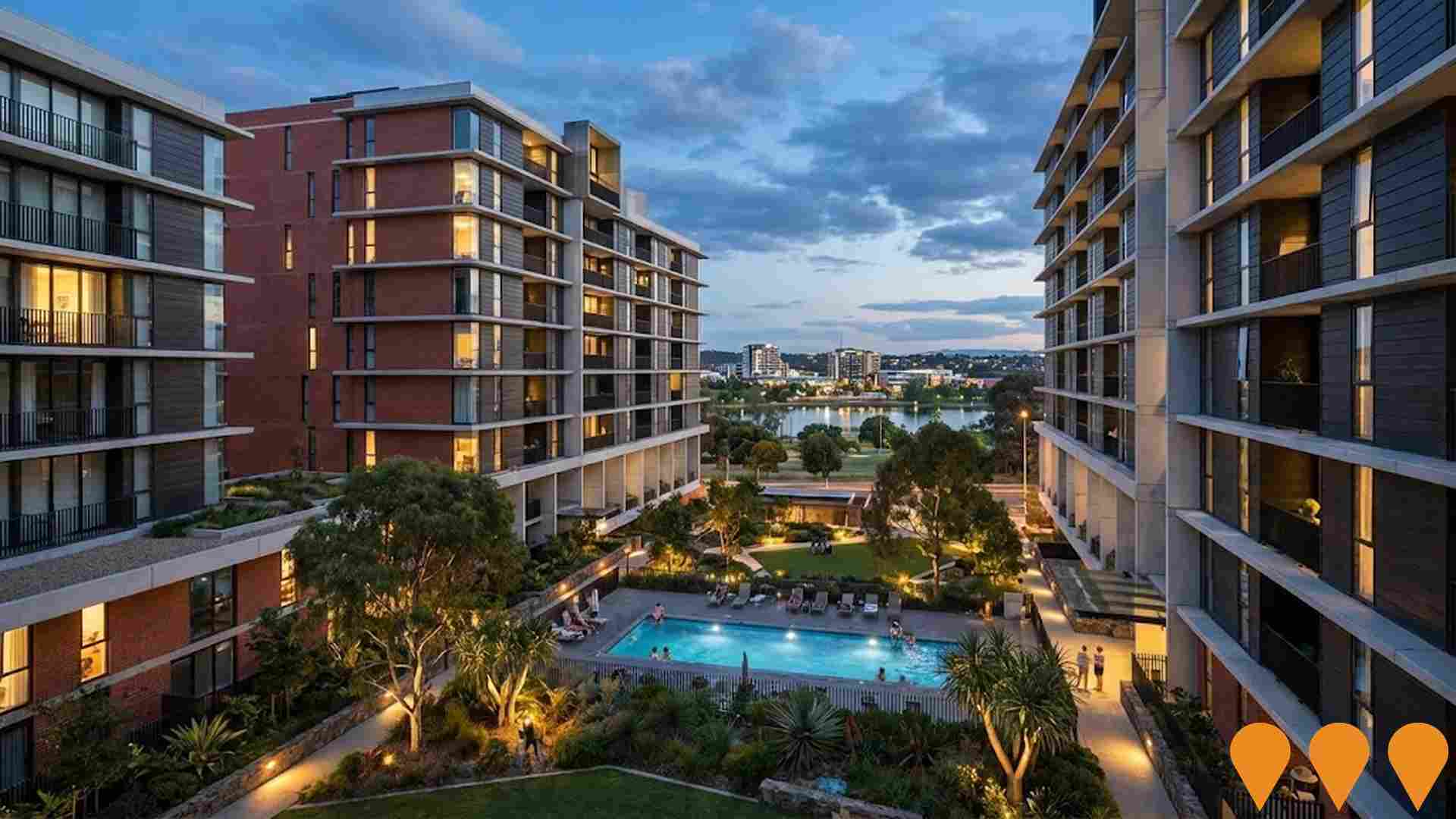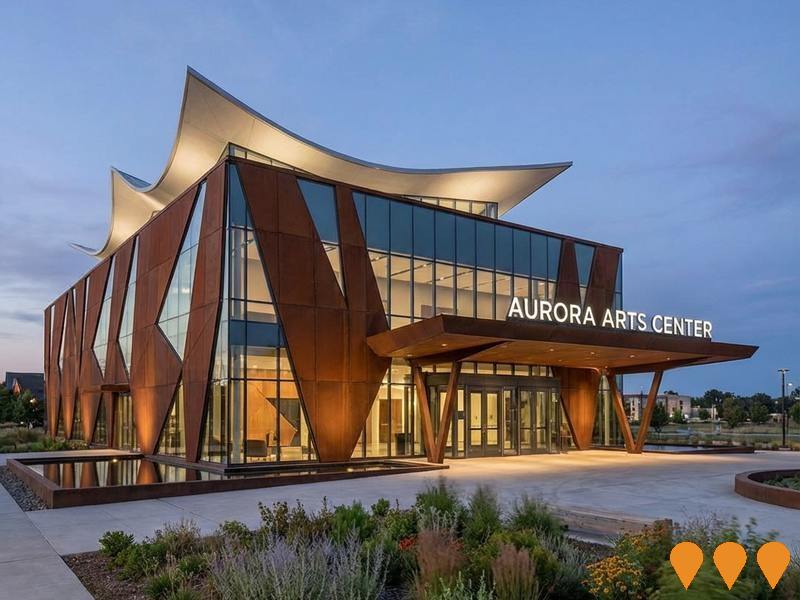Chart Color Schemes
est. as @ -- *
ABS ERP | -- people | --
2021 Census | -- people
Sales Activity
Curious about local property values? Filter the chart to assess the volume and appreciation (including resales) trends and regional comparisons, or scroll to the map below view this information at an individual property level.
Find a Recent Sale
Sales Detail
Population
McKellar has shown very soft population growth performance across periods assessed by AreaSearch
As of Aug 2025, McKellar's population is approximately 2,633, a decrease of 107 people from the 2021 Census figure of 2,740. This decline represents a 3.9% change since the census date. The current population estimate is based on ABS data from June 2024 and address validation. The population density in McKellar stands at 1,867 persons per square kilometer, higher than the average across national locations assessed by AreaSearch. Overseas migration contributed roughly 56.2% of overall population gains in recent periods.
AreaSearch uses ABS/Geoscience Australia projections for each SA2 area, released in 2024 with a base year of 2022. For areas not covered and years post-2032, age group growth rates from the ACT Government's SA2 area projections are adopted, using 2022 as the base year. According to these projections, McKellar's population is expected to decrease by 499 persons by 2041. However, specific age cohorts are projected to grow, notably the 75 to 84 age group, which is anticipated to increase by 42 people over this period.
Frequently Asked Questions - Population
Development
The level of residential development activity in McKellar is very low in comparison to the average area assessed nationally by AreaSearch
McKellar has seen approximately one new home approved annually. Over the past five financial years, from FY21 to FY25, around five homes were approved.
No approvals have been recorded so far in FY26. Despite population decline, development activity has been adequate relative to other areas, offering more affordable housing options with an average dwelling construction cost of $262,000, below the regional average. Compared to the Australian Capital Territory, McKellar shows significantly reduced construction activity, 94.0% below the regional average per person. This limited new supply generally supports stronger demand and values for established properties. The area's recent building activity consists entirely of standalone homes, maintaining its traditional suburban character with a focus on family homes appealing to those seeking space.
With approximately 2646 people per dwelling approval, McKellar demonstrates an established market. Given stable or declining population forecasts, the area may experience less housing pressure in the future, creating favourable conditions for buyers.
Frequently Asked Questions - Development
Infrastructure
McKellar has emerging levels of nearby infrastructure activity, ranking in the 24thth percentile nationally
No local infrastructure changes or major projects have been identified by AreaSearch as likely impacting the area. Key projects include Wayfarer Belconnen Stage 2 by Geocon, Onderra, Bruce Innovation District, and Belconnen Lakeshore - Connected Waterfront Precinct.
Professional plan users can use the search below to filter and access additional projects.
INFRASTRUCTURE SEARCH
 Denotes AI-based impression for illustrative purposes only, not to be taken as definitive under any circumstances. Please follow links and conduct other investigations from the project's source for actual imagery. Developers and project owners wishing us to use original imagery please Contact Us and we will do so.
Denotes AI-based impression for illustrative purposes only, not to be taken as definitive under any circumstances. Please follow links and conduct other investigations from the project's source for actual imagery. Developers and project owners wishing us to use original imagery please Contact Us and we will do so.
Frequently Asked Questions - Infrastructure
Canberra Light Rail Stage 3: Belconnen to City (Bruce Alignment)
Planning and feasibility analysis for the future Stage 3 of the Canberra Light Rail network, connecting Belconnen Town Centre to the City via Bruce. The proposed corridor serves major precincts including the University of Canberra, CIT Bruce, North Canberra Hospital, and GIO Stadium. The project follows the Belconnen Transitway alignment and aims to provide high-capacity public transport to the north-west.

New Northside Hospital (North Canberra Hospital Redevelopment)
Development of a new major tertiary hospital on the existing North Canberra Hospital campus (formerly Calvary Public Hospital). The project involves an investment of over $1 billion to construct a new state-of-the-art clinical services building, expanded emergency department, and modern inpatient facilities to replace aging infrastructure.
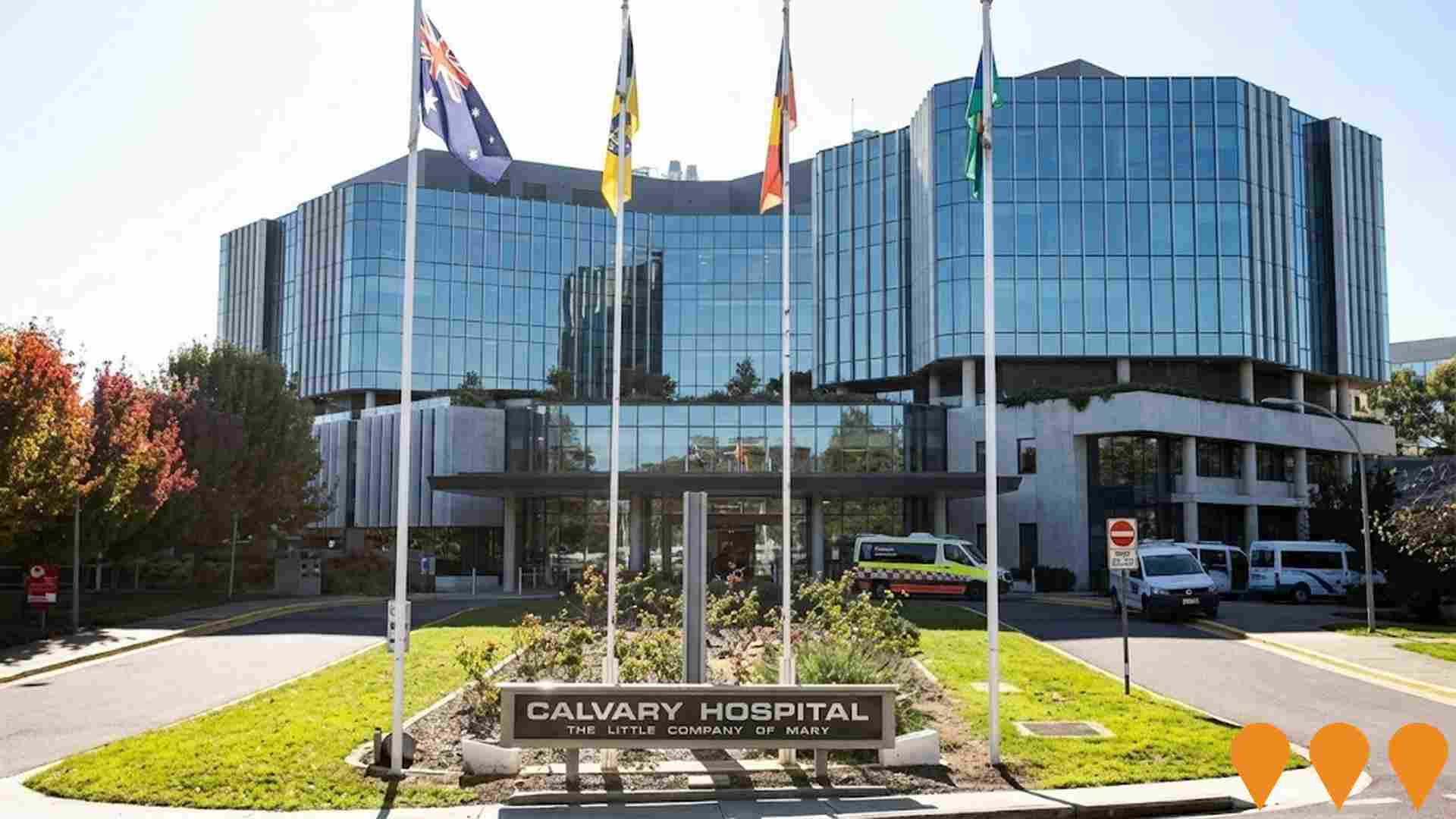
Onderra
Onderra is a large-scale sustainable masterplanned community by Peet Limited on the University of Canberra campus in Bruce, ACT. The 15-hectare precinct will deliver approximately 1,600 high-quality terraces, townhouses and apartments with 7-8 star energy ratings, extensive tree retention, solar-passive design, rainwater harvesting, EV charging and direct access to Lake Ginninderra and 22 hectares of connected parks and open space.

Belconnen Lakeshore - Connected Waterfront Precinct
Belconnen Lakeshore is an ACT Government land release and urban renewal project on the Lake Ginninderra foreshore at Emu Inlet. Guided by the Belconnen Town Centre Place Design Brief, the project will transform four waterfront sites including the Circus Sites Precinct and the former Water Police site into a mixed use precinct with new public waterfront promenades, upgraded open space and taller mixed use buildings stepping up from the lake edge. The Suburban Land Agency has run a two stage tender process for the land release and evaluated tenders, but as at mid 2025 the lakeshore blocks have not yet been sold, with final sale and detailed development design still to be confirmed.

Belconnen Town Centre East Precinct (Republic Phase 2 & Future)
Major mixed-use redevelopment of the former Belconnen Bowling Club site and surrounding land in Belconnen Town Centre (approx. 5 km from Dunlop), delivering apartments, retail, and public spaces.
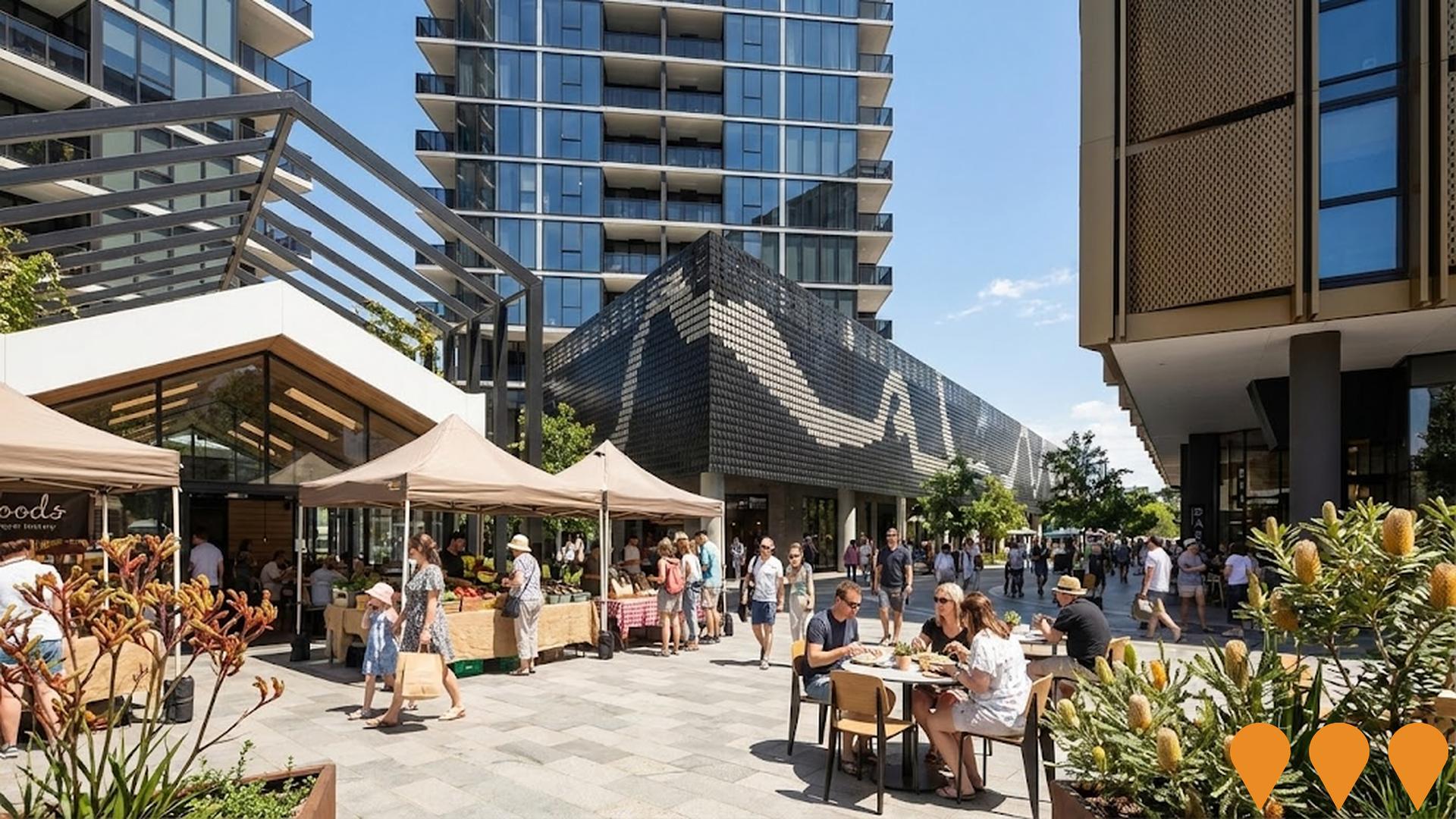
Enhanced bus and light rail corridors (Belconnen & Queanbeyan to Central Canberra)
ACT is progressing an integrated program to enhance high-frequency bus and future light rail corridors that link Belconnen and Queanbeyan with central Canberra. Light Rail Stage 2A (City to Commonwealth Park) commenced construction in early 2025 with services targeted from 2028, while planning and approvals continue for Stage 2B to Woden. The ACT Government has acknowledged and is planning upgrades for the Belconnen-to-City bus corridor as groundwork for a future east-west light rail Stage 3, and is coordinating cross-border public transport initiatives with NSW through the Queanbeyan Region Integrated Transport Plan and the ACT-NSW MoU for Regional Collaboration.
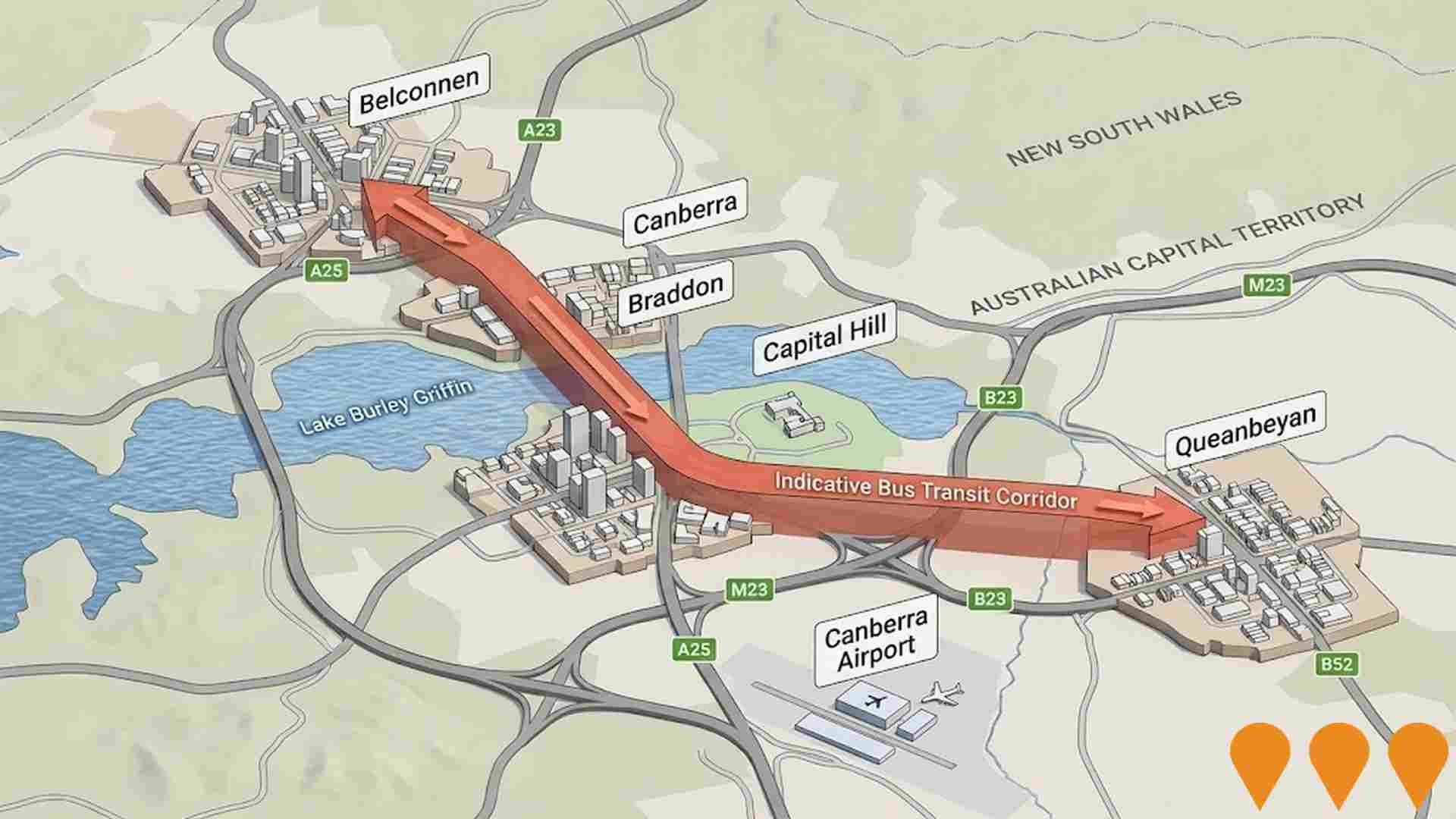
Bruce Innovation District
Proposed innovation district in Bruce to attract technology companies, research organizations, and startups. The district would provide modern office spaces, research facilities, and collaboration hubs to foster innovation and economic development.
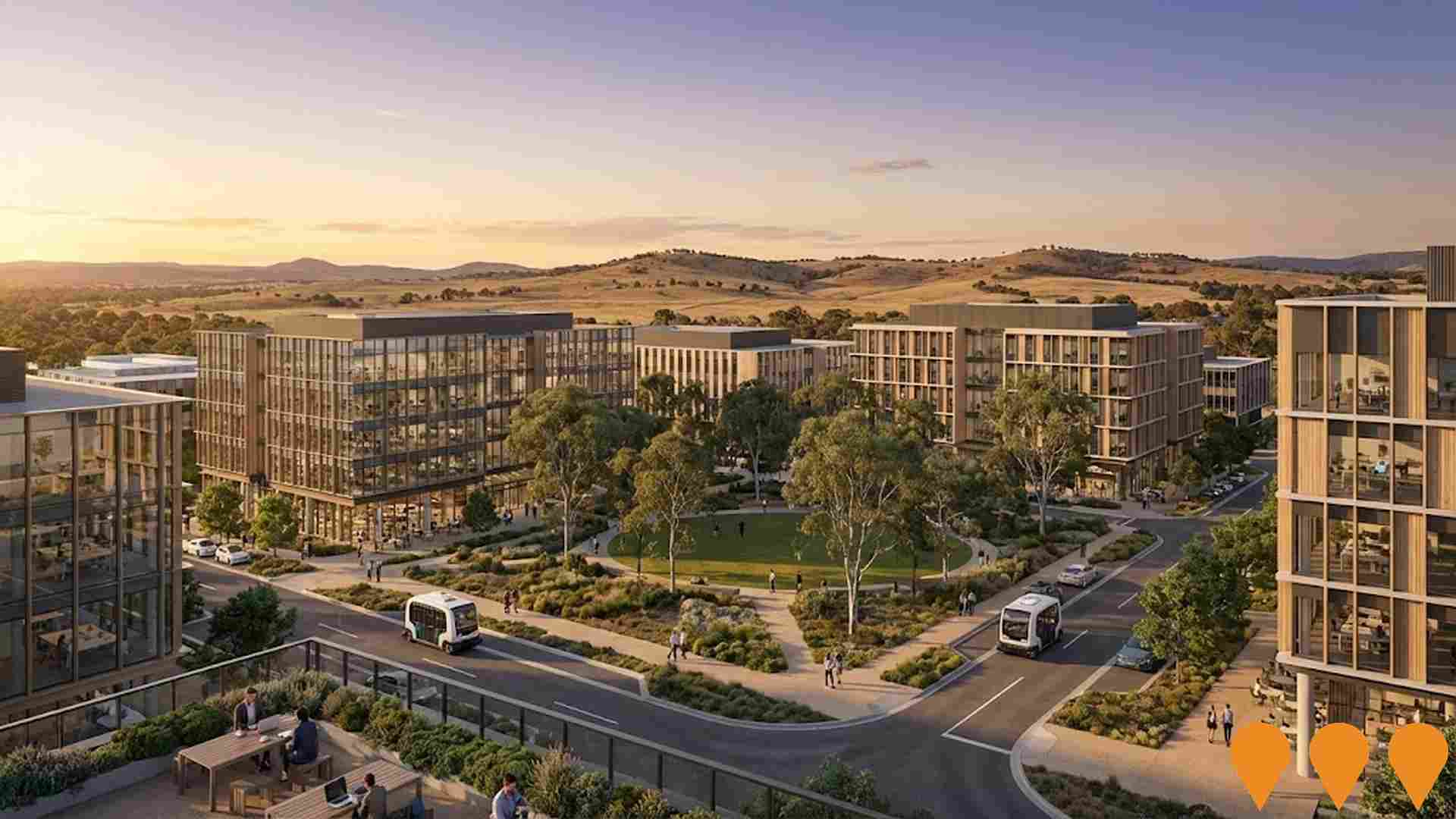
Kenny New Suburb Development
155-hectare new suburb between Watson and Harrison for 4,000+ residents. Will include diverse housing options, local centre, community facilities and connection to Nadjung Mada Nature Reserve. First land releases planned for 2025-26.
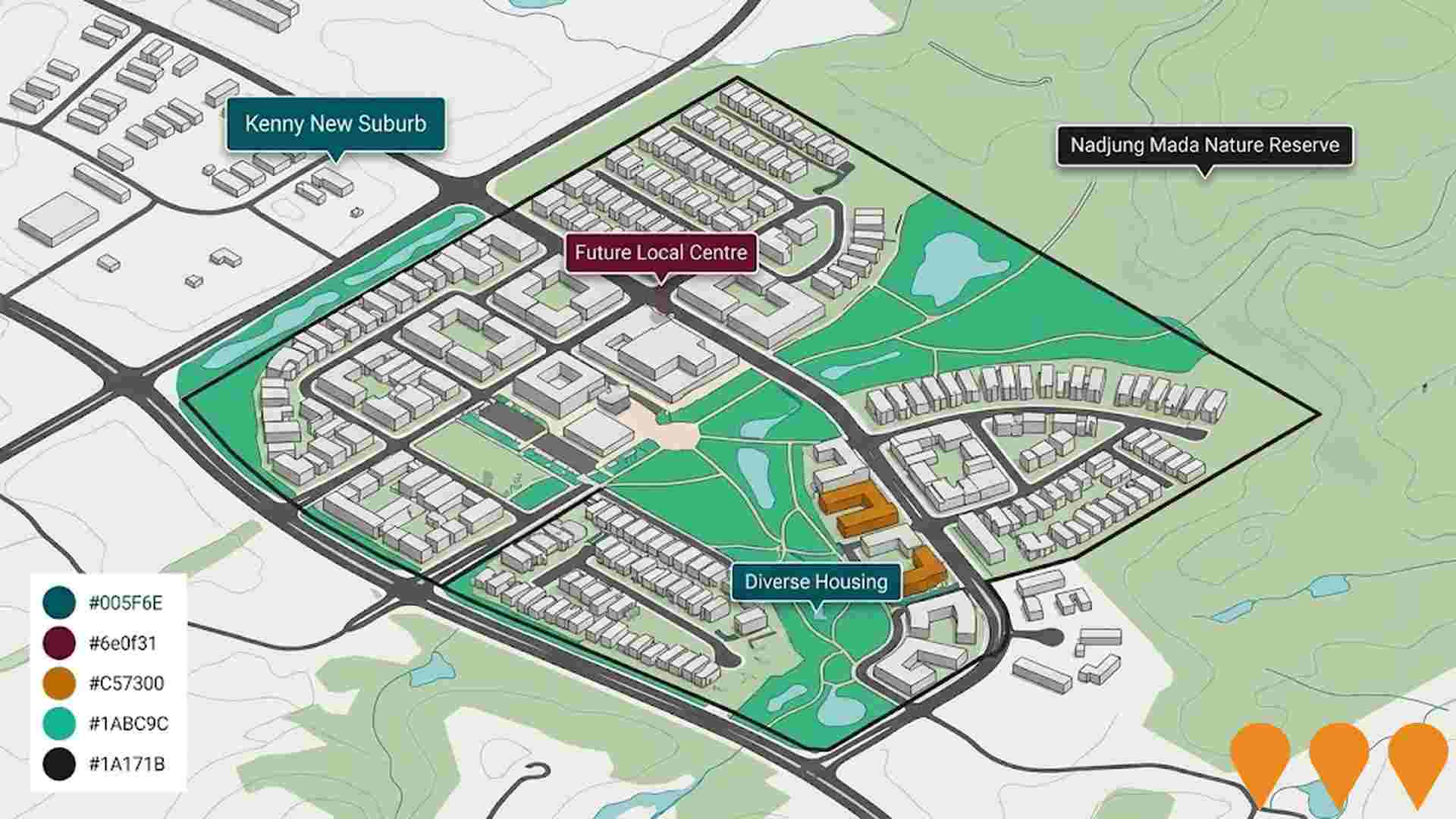
Employment
The employment landscape in McKellar shows performance that lags behind national averages across key labour market indicators
McKellar has an educated workforce with prominent representation in essential services sectors. The unemployment rate was 3.9% as of June 2025, with an estimated employment growth of 1.5% over the past year.
There were 1,395 residents employed by June 2025, with an unemployment rate of 4.4%, compared to the Australian Capital Territory's (ACT) rate of 3.4%. Workforce participation in McKellar was 62.3%, lower than ACT's 69.6%. Key industries for employment among residents were public administration & safety, professional & technical services, and health care & social assistance. Notably, construction had employment levels at 1.4 times the regional average.
However, public administration & safety had limited presence with 27.8% employment compared to 30.4% regionally. The area offered limited local employment opportunities as indicated by Census data. Over the year to June 2025, employment increased by 1.5%, while labour force grew by 1.5%, and unemployment remained largely unchanged at 3.9%. In contrast, ACT saw employment rise by 1.9% and unemployment fall to 3.1%. National employment forecasts from Jobs and Skills Australia (May 2025) project national growth of 6.6% over five years and 13.7% over ten years. Applying these projections to McKellar's employment mix suggests local growth of approximately 6.5% over five years and 13.3% over ten years, though this is a simple extrapolation for illustrative purposes only.
Frequently Asked Questions - Employment
Income
The economic profile demonstrates exceptional strength, placing the area among the top 10% nationally based on comprehensive AreaSearch income analysis
AreaSearch's latest postcode level ATO data for financial year ending June 2022 shows median income in McKellar at $64,878 and average income at $78,350. This compares to Australian Capital Territory's median income of $68,678 and average income of $83,634. Based on Wage Price Index growth of 13.6% from July 2022 to September 2025, estimated current incomes are approximately $73,701 (median) and $89,006 (average). Census 2021 income data ranks McKellar between the 89th and 94th percentiles nationally for household, family, and personal incomes. Income distribution shows 27.3% of locals (718 people) earning $1,500 - 2,999 weekly, with 45.3% earning above $3,000 weekly after tax. After housing costs, residents retain 89.8% of income. The area's SEIFA income ranking places it in the 8th decile.
Frequently Asked Questions - Income
Housing
McKellar is characterized by a predominantly suburban housing profile, with above-average rates of outright home ownership
The dwelling structure in McKellar, as per the latest Census, consisted of 93.7% houses and 6.3% other dwellings (semi-detached, apartments, 'other' dwellings). In comparison, the Australian Capital Territory had 69.4% houses and 30.5% other dwellings. Home ownership in McKellar was 42.8%, with mortgaged dwellings at 38.0% and rented ones at 19.2%. The median monthly mortgage repayment in the area was $2,167, higher than the Australian Capital Territory average of $2,000. The median weekly rent figure in McKellar was $438, compared to the Australian Capital Territory's $430. Nationally, McKellar's mortgage repayments were significantly higher at $2,167 compared to the Australian average of $1,863, while rents were substantially above the national figure of $375.
Frequently Asked Questions - Housing
Household Composition
McKellar features high concentrations of family households, with a higher-than-average median household size
Family households constitute 79.4% of all households, including 35.7% couples with children, 32.9% couples without children, and 10.7% single parent families. Non-family households comprise the remaining 20.6%, with lone person households at 17.6% and group households comprising 2.9%. The median household size is 2.7 people, larger than the Australian Capital Territory average of 2.5.
Frequently Asked Questions - Households
Local Schools & Education
McKellar performs slightly above the national average for education, showing competitive qualification levels and steady academic outcomes
In McKellar, 42.3% of residents aged 15+ have university qualifications, exceeding Australia's average of 30.4%. The area has a strong educational advantage with bachelor degrees being the most common (25.3%), followed by postgraduate qualifications (11.6%) and graduate diplomas (5.4%). Vocational pathways account for 24.9% of qualifications, including advanced diplomas at 9.2% and certificates at 15.7%. Educational participation is high with 27.6% of residents currently enrolled in formal education, broken down as follows: primary education (8.6%), secondary education (7.1%), and tertiary education (6.1%).
Educational facilities seem to be located outside McKellar's immediate boundaries, requiring families to access schools in neighboring areas.
Frequently Asked Questions - Education
Schools Detail
Nearby Services & Amenities
Transport
Transport servicing is good compared to other areas nationally based on assessment of service frequency, route connectivity and accessibility
The public transport analysis indicates that McKellar has 24 active transport stops in operation. These stops serve a mix of bus routes, with a total of 3 individual routes providing service to the area. The combined weekly passenger trips across these routes amount to 687.
Residents enjoy excellent transport accessibility, with an average distance of 151 meters to the nearest transport stop. Service frequency is high, averaging 98 trips per day across all routes, which translates to approximately 28 weekly trips per individual stop.
Frequently Asked Questions - Transport
Transport Stops Detail
Health
McKellar's residents are relatively healthy in comparison to broader Australia with a fairly standard level of common health conditions seen across both young and old age cohorts
McKellar's health metrics closely match national benchmarks.
Common health conditions are seen at standard levels across both young and old age cohorts. Private health cover is exceptionally high at approximately 59% of the total population (1,548 people). The most common medical conditions are arthritis and asthma, impacting 9.7 and 7.8% of residents respectively. 68.0% of residents declare themselves completely clear of medical ailments, compared to 68.1% across Australian Capital Territory. 21.0% of residents are aged 65 and over (552 people), higher than the 15.3% in Australian Capital Territory. Health outcomes among seniors are particularly strong, performing better than the general population in health metrics.
Frequently Asked Questions - Health
Cultural Diversity
McKellar was found to be more culturally diverse than the vast majority of local markets in Australia, upon assessment of a range of language and cultural background related metrics
McKellar's population showed high diversity with 31.0% born overseas and 27.2% speaking a language other than English at home. Christianity was the predominant religion, comprising 50.9%. Buddhism was slightly overrepresented at 3.6%, compared to 3.0% in Australian Capital Territory.
The top three ancestral groups were Australian (22.7%), English (21.4%), and Other (11.2%). Some ethnic groups showed notable divergences: Croatian (2.4% vs regional 0.8%), Polish (1.1% vs 0.8%), and Serbian (0.7% vs 0.3%) were overrepresented in McKellar.
Frequently Asked Questions - Diversity
Age
McKellar hosts an older demographic, ranking in the top quartile nationwide
McKellar's median age is 43 years, which is significantly higher than the Australian Capital Territory average of 35 years and considerably older than the Australian median of 38 years. Compared to the Australian Capital Territory average, the 65-74 cohort is notably over-represented at 12.9% locally, while the 25-34 age group is under-represented at 12.3%. According to the 2021 Census, the 75-84 age group has grown from 4.8% to 6.7% of McKellar's population, whereas the 45-54 cohort has declined from 12.8% to 11.8%. Demographic modeling suggests that by 2041, McKellar's age profile will evolve significantly. The 75-84 cohort is projected to grow by 18%, adding 31 residents to reach a total of 209. This growth is part of an overall demographic aging trend, with residents aged 65 and older representing 100% of anticipated population growth. Conversely, population declines are projected for the 0-4 and 15-24 age groups.

